Try Default

See how revenue teams automate revenue operations with Default.

Key Takeaways
- Default is built for RevOps and GTM teams who need more than visibility—it handles tracking, enrichment, routing, and scheduling in one canvas. Ideal for converting live buyer signals into booked meetings, automatically.
- Leadfeeder gives outbound teams a quick, lightweight way to see which accounts are visiting, using IP-matching and basic alerts. Great for early-stage sales teams without ops support.
- Clearbit overlays firmographic data and intent signals on anonymous traffic—ideal for marketing teams running personalized campaigns and audience-based workflows.
- Albacross is a privacy-first option for EMEA-focused GTM teams. It’s a plug-and-play way to surface in-region traffic without GDPR friction.
You’re getting site traffic—but most of it’s anonymous, unconverted, and gone before sales ever sees it.
The problem? You’re blind to buyer intent. You don’t know which accounts are showing real interest, what pages matter most, or when to trigger action. And without that context, pipeline slows before it even starts.
This guide breaks down 11 of the best website visitor tracking tools for B2B teams in 2025—but not just by features. We’ll help you choose based on how each tool fits your GTM motion, whether that means lightweight account intel or full-funnel orchestration with enrichment, routing, and meeting automation.
Here’s how the top tools stack up—side by side.
Comparison table: best website visitor tracking tools (2025)
Default: Best website visitor tracking software

Default isn’t just a visitor tracking tool—it’s your GTM operating layer.
Built for RevOps, GTM, and demand gen teams, Default doesn’t just show you who’s on your site. It tells you what to do next—and automates the entire path from signal to scheduled meeting.
Every visitor session can trigger routing, AI lead enrichment, alerts, scheduling, or CRM updates—directly from one visual sales workflow canvas. No missed signals. No manual follow-up. No duct-taped stack.
If you’re serious about acting on buyer intent in real time—and scaling without extra headcount—Default was built for that.
Key features
Default isn’t just about seeing who’s on your site—it’s about converting that signal while it still matters. Here’s how high-performing GTM teams automate the next step:
1. Real-time visitor tracking with CRM enrichment
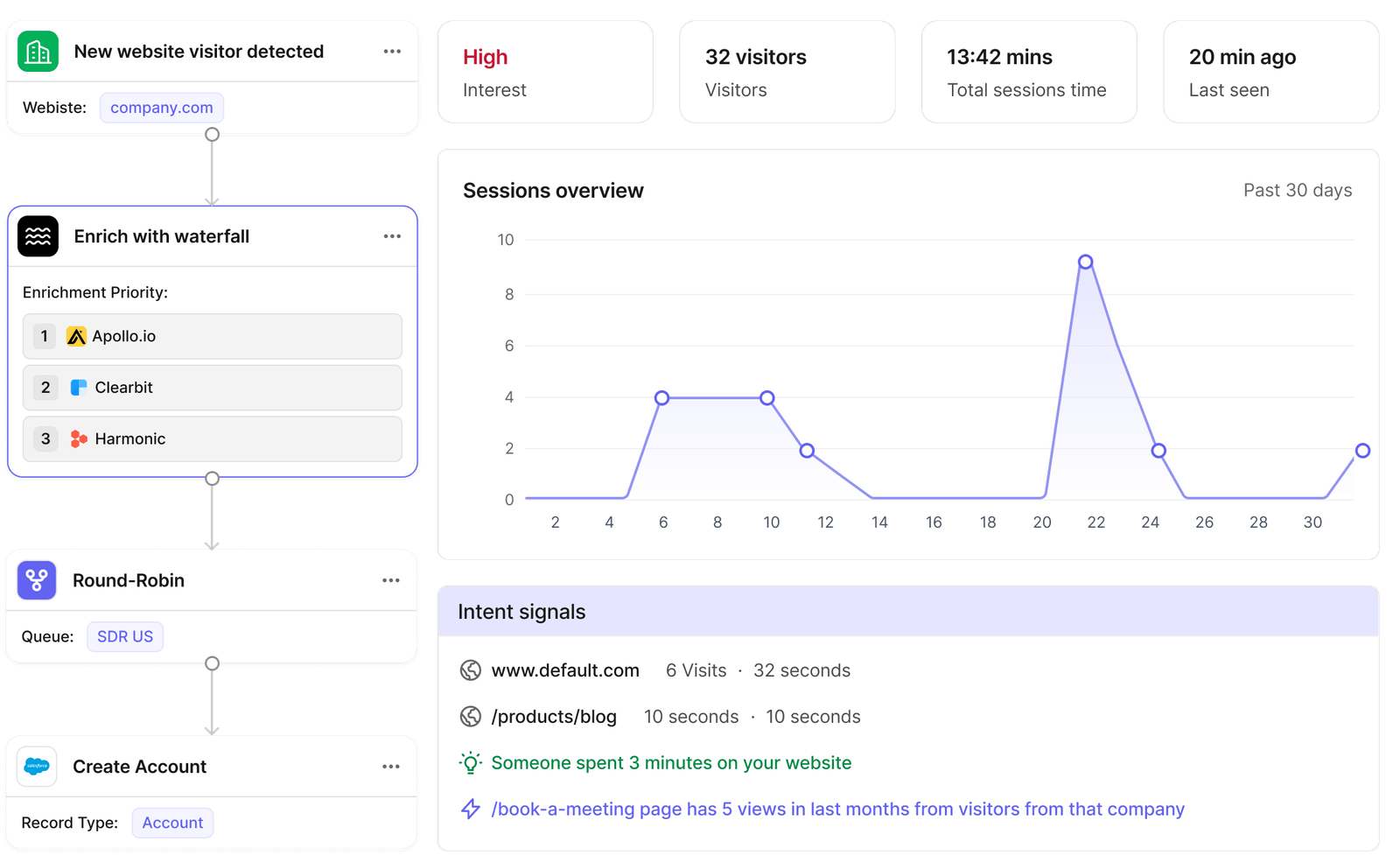
The second someone lands, Default resolves the company and enriches the session with firmographic and technographic data—company name, size, industry, even pipeline stage—before they ever touch a form.
Why it matters: reps don’t waste time on cold leads. They engage warm accounts already showing intent.
2. Visual lead routing & scheduling workflows
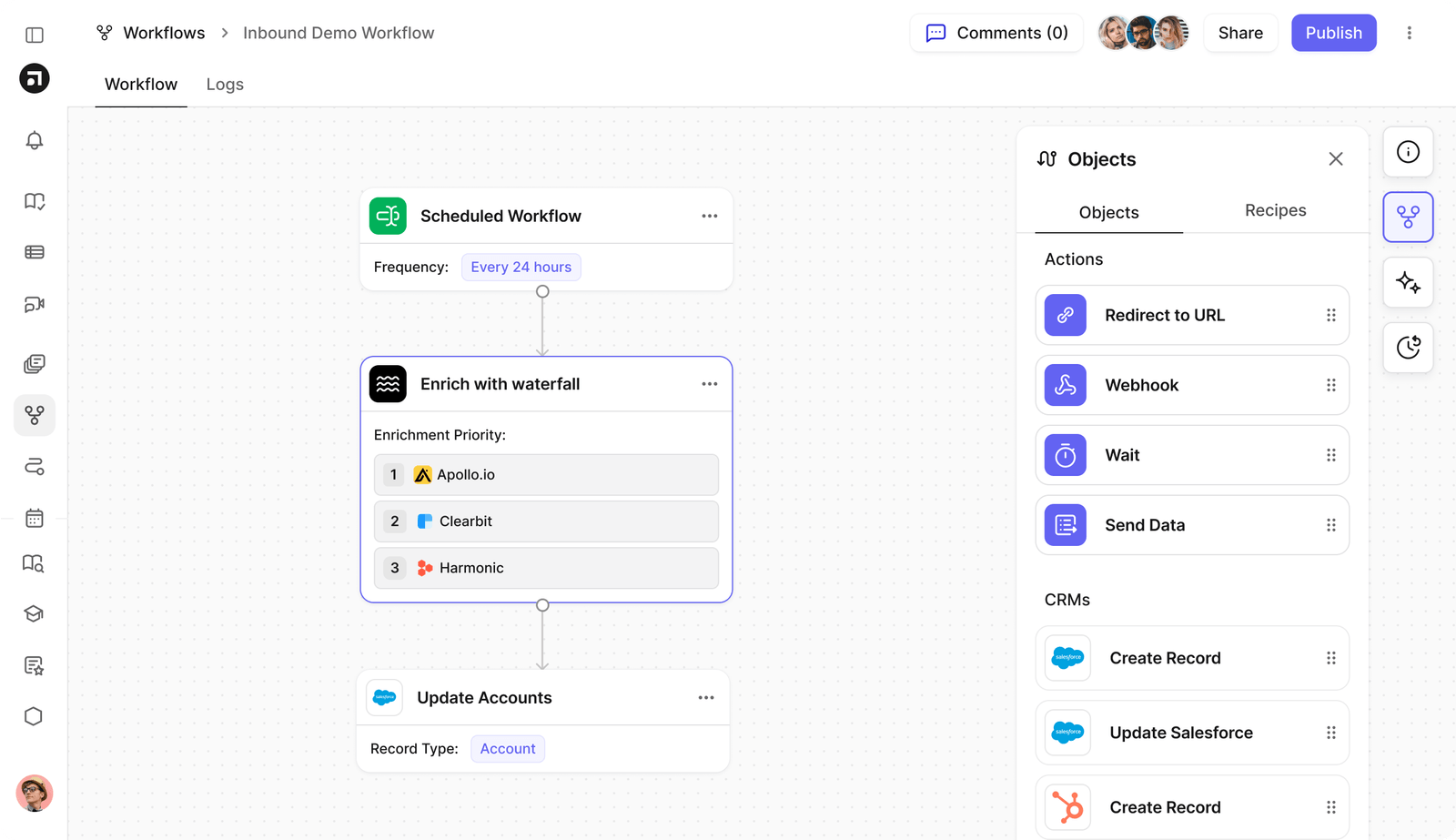
Ops teams use Default’s drag-and-drop canvas to set routing logic by territory, rep, product line, or any CRM field. Once a rule hits, Default can:
- Assign the lead
- Fire a booking link
- Trigger a Slack alert
- Sync to Salesforce or HubSpot
Why it matters: speed-to-lead drops from hours to seconds. No rep lag, no manual handoff.
3. Intent-triggered alerts with CRM + Slack sync
When a decision-maker hits your pricing page, demo flow, or support docs, Default pushes that signal—live—into your CRM and Slack.
Why it matters: sales doesn’t guess who’s ready. They know, and they act while the window’s open.
Pricing
Where Default shines
- Unified orchestration across inbound GTM: Default replaces 3–5 tools by combining real-time tracking, enrichment, routing, and scheduling into one canvas, with full CRM visibility.
- Speed-to-lead without human lag: Instead of hoping reps follow up on MQL alerts, Default routes, alerts, and books meetings automatically, minutes after high-intent visits.
- RevOps control with full visibility: Workflow logic, lead ownership, and alerts are all transparent—with logs, versioning, and rollback for every automation.
Where Default falls short
- Not ideal for early-stage teams: If you’re not yet working inbound leads through a CRM, Default may feel overpowered for your needs.
- No UX analytics: It’s built for pipeline orchestration—not session replays, scroll depth, or mouse tracking.
Customer reviews
“Really easy to set up an inbound lead workflow. Default allows you to route leads based on form input and enrichment by other tools like Clearbit and Apollo. Follow-up mails, notification and CRM integrations mean that we no longer need to stitch 5 tools together to get the job done. Customer support is quick and helpful.” - Jules J., verified G2 reviewer
“It takes the headache out of inbound scheduling and qualification. We're able to set qualification parameters, so if someone signs up and meets our ICP, they can instantly book a meeting with a sales rep, eliminating the back and forth and saving us hours. Plus, the way it integrates with our existing tools like Hubspot and Slack makes the whole process feel seamless. Our inbound conversion rate went up significantly thanks to Default!” - Brandon P., verified G2 reviewer
Who Default is best for
- RevOps leaders: Need complete visibility and control over lead capture, routing, and attribution—from form fill to booked meeting.
- Demand gen teams: Want to act on buyer intent in real time and reduce funnel friction without dev support.
- SDR and sales-assist managers: Need reliable alerts, live signals, and automated workflows to prioritize high-intent accounts faster.
Leadfeeder: Best for outbound sales teams focused on account-level visibility
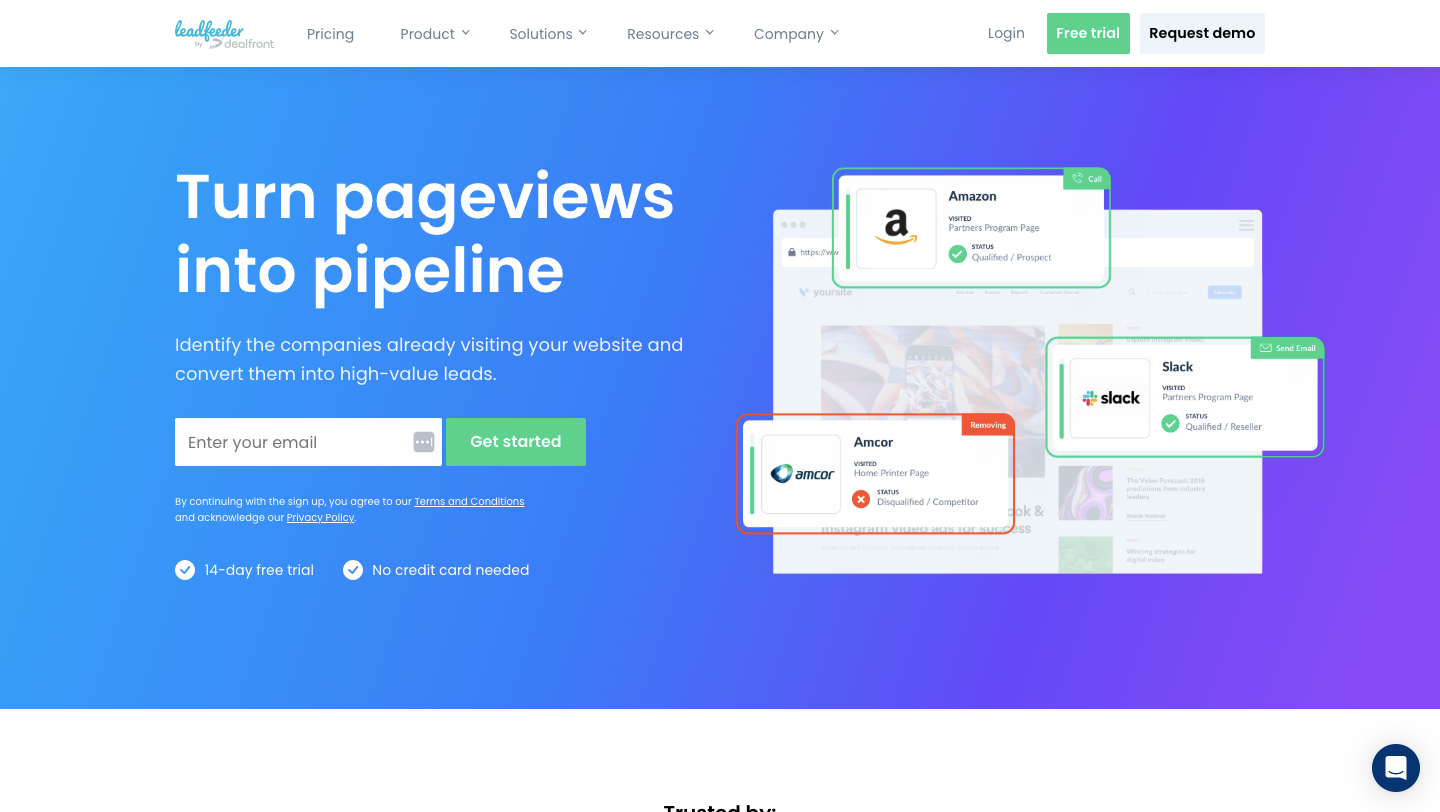
Leadfeeder helps outbound teams surface which companies are hitting their site—without needing a full RevOps setup.
It uses IP-to-company matching to turn anonymous traffic into account-level visibility, giving SDRs a warm list to work from. It won’t show you individual buyer signals or trigger workflows, but for teams focused on outbound prospecting, it’s a lightweight way to add intent context to your sales motion.
Just note: it won’t route leads, schedule meetings, or sync buyer behavior into your CRM in real time. If you're running inbound or blended GTM, you'll likely need additional tools on top.
Key features
- Company identification: Uses IP-to-company resolution to expose firmographics like size, industry, and location.
- CRM integrations: Syncs directly with Salesforce, HubSpot, Pipedrive, and more.
- Lead filters: Segment visitors by behavior, source, pageviews, campaign UTM, and more.
- Slack & email alerts: Get notified when target accounts hit key pages—like pricing or case studies.
Pricing
Where Leadfeeder shines
- Fast setup, low friction: Minimal implementation effort, ideal for teams without ops support.
- Daily sales prioritization: Helps SDRs know who to reach out to, right from their inbox.
- Affordable starting point: Good value for orgs early in their tracking or outbound journey.
Where Leadfeeder falls short
- No contact-level data enrichment: You’ll need another tool to find buyer emails or job titles.
- IP-based limitations: Doesn’t always capture smaller companies or remote users with dynamic IPs.
- Limited automation: No built-in routing, scoring, or scheduling logic—unlike Default.
Customer reviews
“It is easy to see and identify website visitors and filter out not interesting leads. The best part is that my team needs no training or onboarding, it is so simple to use. Integrates directly to our CRM, we use Pipedrive.” - Pekka H., verified G2 reviewer
“The interface could offer more filter and sort possibilities. It is not very practical to work with the lead list as it is without making selections.” - Oksana V. K., verified G2 reviewer
Who Leadfeeder is best for
- Outbound SDR teams: Need lightweight account intel to guide prospecting efforts.
- GTM teams without ops support: Want plug-and-play tracking without custom workflows.
- Early-stage B2B orgs: Starting to explore intent-based outreach without full-scale automation.
Clearbit: Best for marketing teams prioritizing lead enrichment and buyer intent signals

Clearbit helps marketing teams turn anonymous website traffic into data-rich audience segments—so you can personalize campaigns and tailor site experiences in real time.
It overlays firmographic and technographic intel on visitors the moment they land, then pipes that data into tools like Salesforce, Segment, or HubSpot. That makes it powerful for building targeted campaigns and suppressing noise early in the funnel.
Just note: Clearbit is designed to power workflows, not own them. You’ll need marketing ops or dev support to wire it into your GTM stack (and other tools to handle routing, scoring, or scheduling).
Key features
- Reveal API: Enriches anonymous visitors instantly with company info, revenue, headcount, and industry.
- Audience builder: Create dynamic segments using firmographic + behavioral logic for targeting or suppression.
- Personalization engine: Dynamically update headlines, CTAs, or page elements based on visitor profile.
- Native integrations: Connects to Salesforce, Segment, HubSpot, Marketo, and other campaign platforms.
Pricing
Where Clearbit shines
- Enrichment + activation: Goes beyond just identifying visitors—lets you act on that data instantly.
- Marketing-led segmentation: Helps ops and growth teams build dynamic campaign logic without waiting on data teams.
- Powerful personalization layer: Can tailor your site experience by segment, intent, or firmographic profile.
Where Clearbit falls short
- No built-in GTM workflows: It’s a data and trigger engine—not a routing, scoring, or scheduling system like Default.
- Requires ops or dev involvement: Setting up Reveal and personalization workflows often needs technical support.
- Opaque pricing: Custom pricing can make forecasting difficult for lean teams.
Customer reviews
“The best part about Clearbit is I can use various filter options to qualify relevant data for me like I can check company size, Location Revenue, etc, and add those prospects to my lead and export them.” - Neel R., verified G2 reviewer
“Platform enablement and user adoption needs to be improved. The Enrichment fails 3/10 times at the Enterprise Level and 6/10 times at the SMB level for Data Enrichment.” - Sidharth I., verified G2 reviewer
Who Clearbit is best for
- Marketing ops teams: Building enrichment and audience targeting into campaign workflows.
- Growth marketers: Personalizing experiences across ads, email, and web based on live data.
Albacross: Best for European businesses needing GDPR-compliant visitor intelligence

Albacross helps EMEA-based GTM teams identify who’s on their site—without stepping on GDPR landmines.
It resolves anonymous traffic to company-level data using a privacy-first IP-matching system, giving sales and outbound teams a compliant way to uncover in-region prospects and prioritize follow-up.
It’s plug-and-play and built for European traffic. But if you need deep customization, workflows, or strong match rates outside the EU, it may not stretch far enough.
Key features
- GDPR-compliant tracking: Uses a proprietary IP resolution method aligned with European privacy standards.
- Firmographic overlays: Identifies company size, industry, revenue, and tech stack in real time.
- Intent scoring: Monitors visit depth, repeat behavior, and page triggers to surface sales-ready accounts.
- CRM and tool integrations: Syncs to HubSpot, Salesforce, Slack, and email outreach tools.
Pricing
Where Albacross shines
- Privacy-first design: Built for GDPR from the start—not retrofitted. Great for legal-conscious orgs.
- In-region targeting: Strongest match rates and identification accuracy for EU-based traffic.
- Simple outbound triggers: Helps SDRs and sales teams surface and prioritize accounts quickly.
Where Albacross falls short
- Limited outside-Europe accuracy: Not optimized for North American or global traffic tracking.
- No routing or automation logic: Lacks scoring-to-booking workflows like Default or Salespanel.
- Lower customization: More plug-and-play; not as extensible as API-heavy platforms like Clearbit.
Customer reviews
“What I like most about Albacross is the discovery of leads (we have a huge amount of website traffic for a fintech provider that we didn't know how to use until this app), the conversion of anonymous leads into our customers, the ability to rescue leads that leave no trace (contact) anywhere, the integration with our CRM, the easy export of prospect lists.” - Anna P., verified G2 reviewer
“Not enough resources (n8n nodes, documentation regarding data engineering treatment of Albacross)” - Maxime M., verified G2 reviewer
Who Albacross is best for
- EMEA GTM teams: Needing firmographic data that aligns with EU privacy laws.
- Sales & outbound orgs: Surfacing in-region target accounts showing intent.
- Privacy-first marketing teams: Prioritizing compliance over deep configurability.
ZoomInfo Chat: Best for enterprise ABM teams needing conversational intelligence + visitor identification

ZoomInfo Chat pairs conversational AI with visitor identification, so enterprise ABM teams can engage high-value accounts the moment they land.
It connects anonymous traffic to ZoomInfo’s contact and company database, then uses firmographic signals to trigger tailored chat flows that qualify leads in real time. It’s tightly integrated into the ZoomInfo ecosystem, which makes it powerful for orgs already using SalesOS; less so if your enrichment or GTM stack lives elsewhere.
Expect value if you’re running high-volume, named-account plays with dedicated SDR coverage. Just know the setup assumes you’re all-in on ZoomInfo.
Key features
- Chat-to-lead intelligence: Engages site visitors with conversational logic while capturing enriched data.
- Real-time identification: Links visitors to ZoomInfo’s extensive B2B database.
- Routing logic: Directs conversations or leads based on firmographic signals or CRM ownership.
- CRM sync: Integrates directly with Salesforce, Marketo, Outreach, and more.
Pricing
Where ZoomInfo Chat shines
- Conversational ABM targeting: Pairs real-time ID with chat flows to engage high-value accounts.
- Deep B2B data integration: Strong match rates through ZoomInfo’s proprietary dataset.
- Contact enrichment on the fly: Instantly fills in buyer fields for SDRs.
Where ZoomInfo Chat falls short
- Enterprise-only pricing: Cost and complexity may be overkill for smaller GTM orgs.
- Heavily tied to ZoomInfo ecosystem: Less flexible for teams using third-party enrichment tools.
Customer reviews
“The robust features and functionality is second to none. From FormComplete, to Intent, to WebSights, Scoops, etc. ZI SalesOS brings it all together.” - Nicholas G., verified G2 reviewer
“It can be difficult to get contact reports to sync with your account book from Salesforce so that you are only getting updated contacts related to your accounts.” - Christoph B., verified G2 reviewer
Who ZoomInfo Chat is best for
- Enterprise ABM orgs: Want real-time chat and visitor ID on high-value accounts.
- SDR teams with named territories: Need instant lead routing by ownership.
- ZoomInfo-native orgs: Already using SalesOS and want unified data + chat flows.
Visitor Queue: Best for SMBs and agencies needing low-cost visitor ID with instant alerts

Visitor Queue gives SMBs and agencies a quick way to see which companies are hitting their site—and sends that intel straight to sales or marketing via Slack or email.
It uses IP resolution to surface firmographic data like company name and industry, helping teams prioritize follow-up without investing in complex routing or scoring tools.
It’s simple, fast to set up, and budget-friendly—but designed for surface-level visibility. If you’re looking to act on buyer intent in real time or integrate workflows, you’ll likely hit its ceiling early.
Key features
- IP-to-company resolution: See who’s visiting and what pages they’re viewing.
- Lead alerts: Notifies sales when target accounts engage key content.
- CRM & Zapier integration: Pushes data into Pipedrive, Salesforce, or custom workflows.
- White-labeling: Available for agencies managing multiple client accounts.
Pricing
Where Visitor Queue shines
- Budget-friendly: Great for lean teams just starting with account-level intel.
- Agency-ready: Offers white-labeled dashboards for client reporting.
- Real-time Slack/email alerts: Keeps sales in sync with mid-funnel behavior.
Where Visitor Queue falls short
- No scoring or routing logic: Can’t trigger complex GTM workflows.
- Limited enrichment: You’ll need another tool to append contact-level data.
Customer reviews
“Having used Visitor Queue with 3 companies I find it a great tool to see who is visiting our site. For existing customers it helps us understand their interest in our products and enables targeted follow-up. For new customers it enables us to add them to our CRM and then target a cold call to make and introduction and see how we can help them.” - Gerry W., verified G2 reviewer
“Nice to have functionality would be more customisable HubSpot Integration and refinement of conversion reporting.” - verified G2 reviewer
Who Visitor Queue is best for
- Small GTM teams: Just starting with visitor ID and real-time intel.
- B2B agencies: Needing easy tracking for client lead reports.
- Budget-conscious orgs: Want basic visitor intel under $100/month.
Salespanel – Best for full-funnel tracking + lead scoring
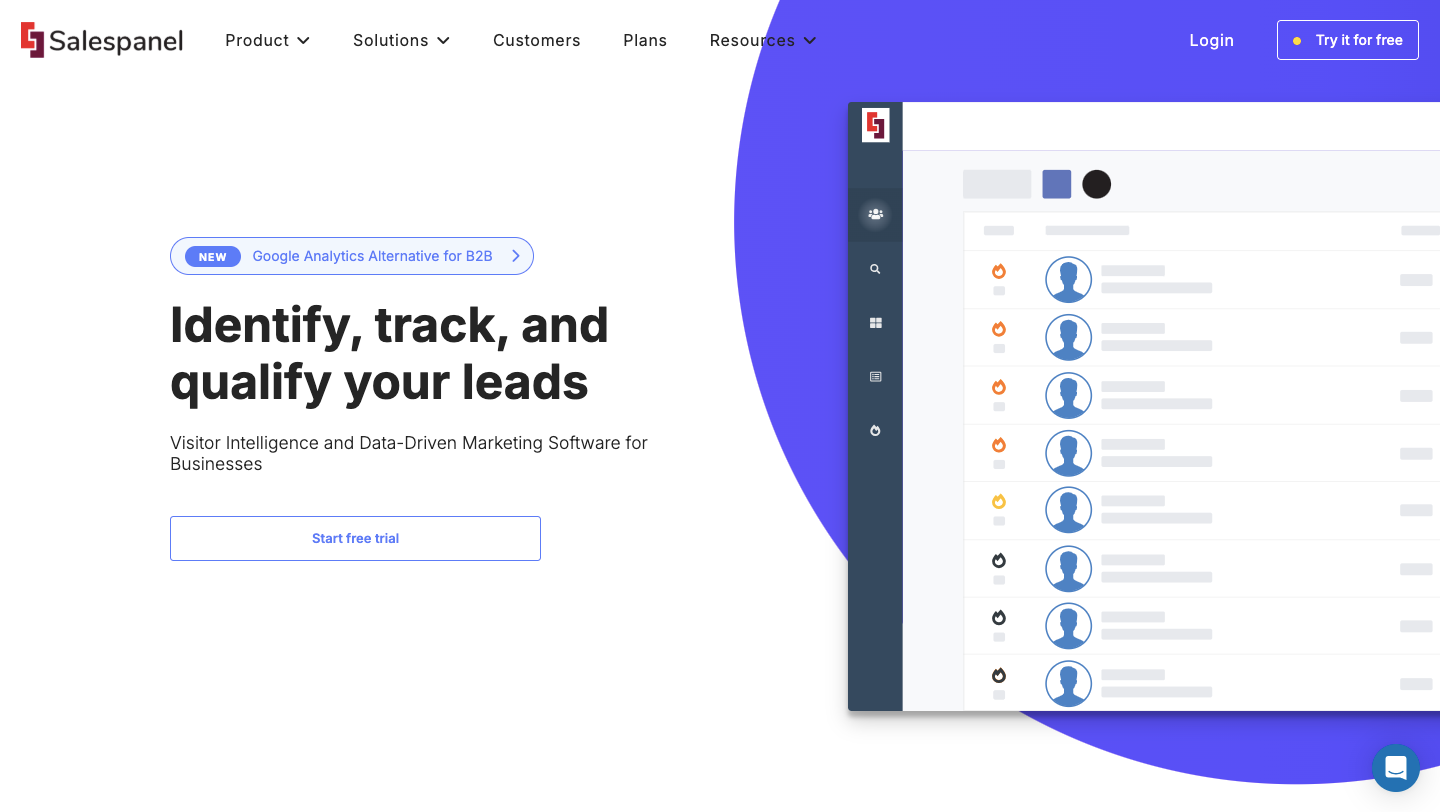
Salespanel tracks user behavior across sessions, channels, and devices, then scores leads using firmographic and engagement data. It supports attribution and lead prioritization across both its Customer Data Platform and Account Reveal plans, starting at $99/month (billed annually).
Salespanel syncs with major CRMs and gives marketing teams a better read on buyer readiness, though it doesn’t include built-in routing or scheduling, and the UI can feel dated.
The higher-tier Salespanel Agents plan ($499/month) adds volume scaling and advanced support.
Best for: Marketing teams focused on attribution; GTM teams prioritizing inbound leads without deep ops support.
Lead Forensics – Best for high-volume enterprise visitor tracking
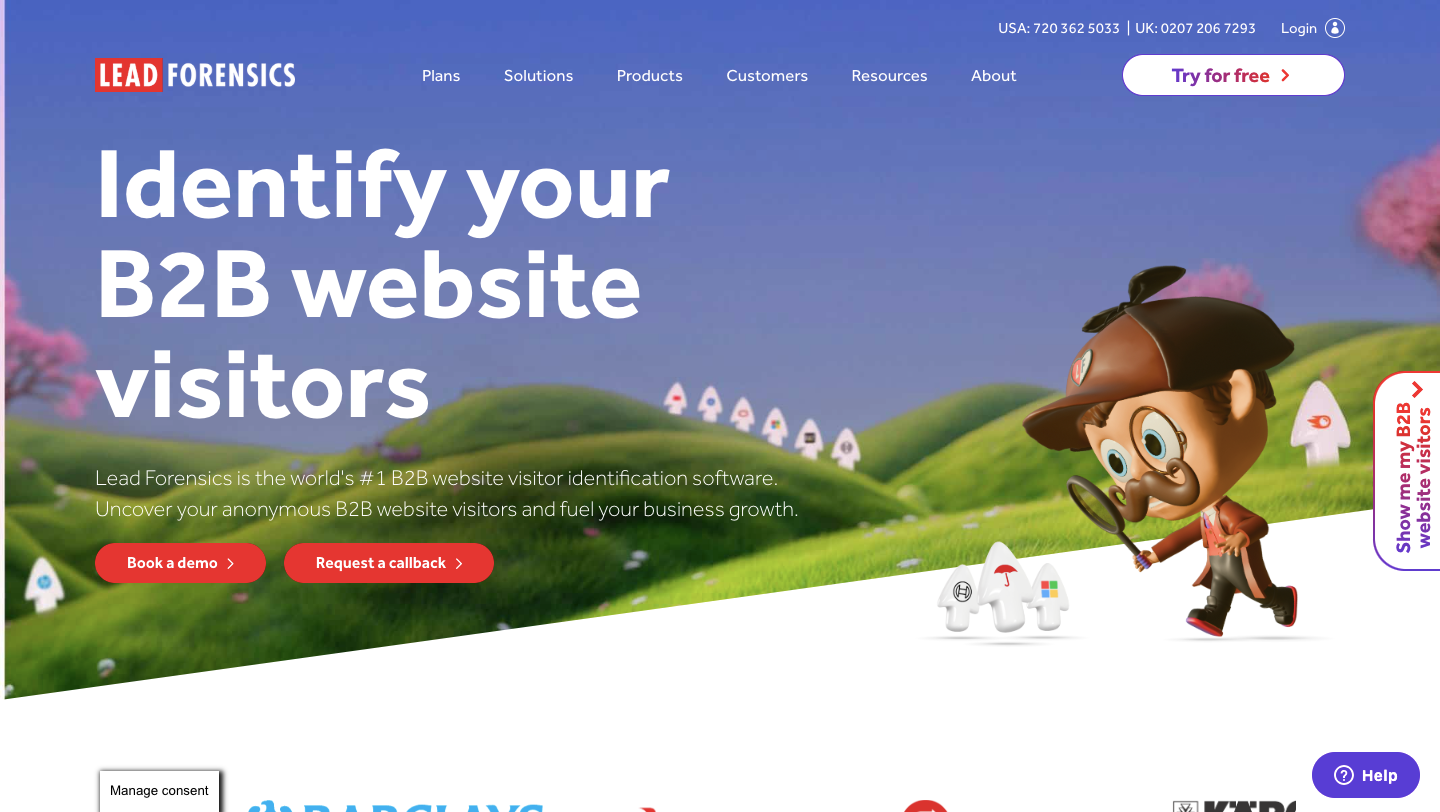
Lead Forensics identifies companies visiting your website and provides access to retroactive traffic data—making it useful for enterprise teams with large inbound volume and a research-driven sales motion.
It’s built around firmographic matching at scale and offers CRM-ready exports, but doesn’t include contact-level enrichment or lead routing.
The platform runs on custom pricing, with plans like Essential and Automate tailored to traffic levels, and includes a free trial to preview results.
Best for: Enterprises with heavy inbound traffic and dedicated sales research teams.
CANDDi – Best for contact-level tracking and multi-session ID

CANDDi focuses on contact-level tracking—capturing individual visitor identities and stitching together behavior across sessions and devices. It’s designed for mid-market sales teams that want to understand how named leads engage after initial contact.
Alongside timeline views and session replays, CANDDi supports plans from $249/month to $789/month, with custom pricing for enterprise.
While it excels at individual visibility, it offers limited integrations and doesn’t handle lead routing or scheduling.
Best for: Sales teams nurturing named leads; mid-market B2B orgs needing cross-session visibility.
Visual Visitor – Best for small teams needing basic visitor ID and alerts
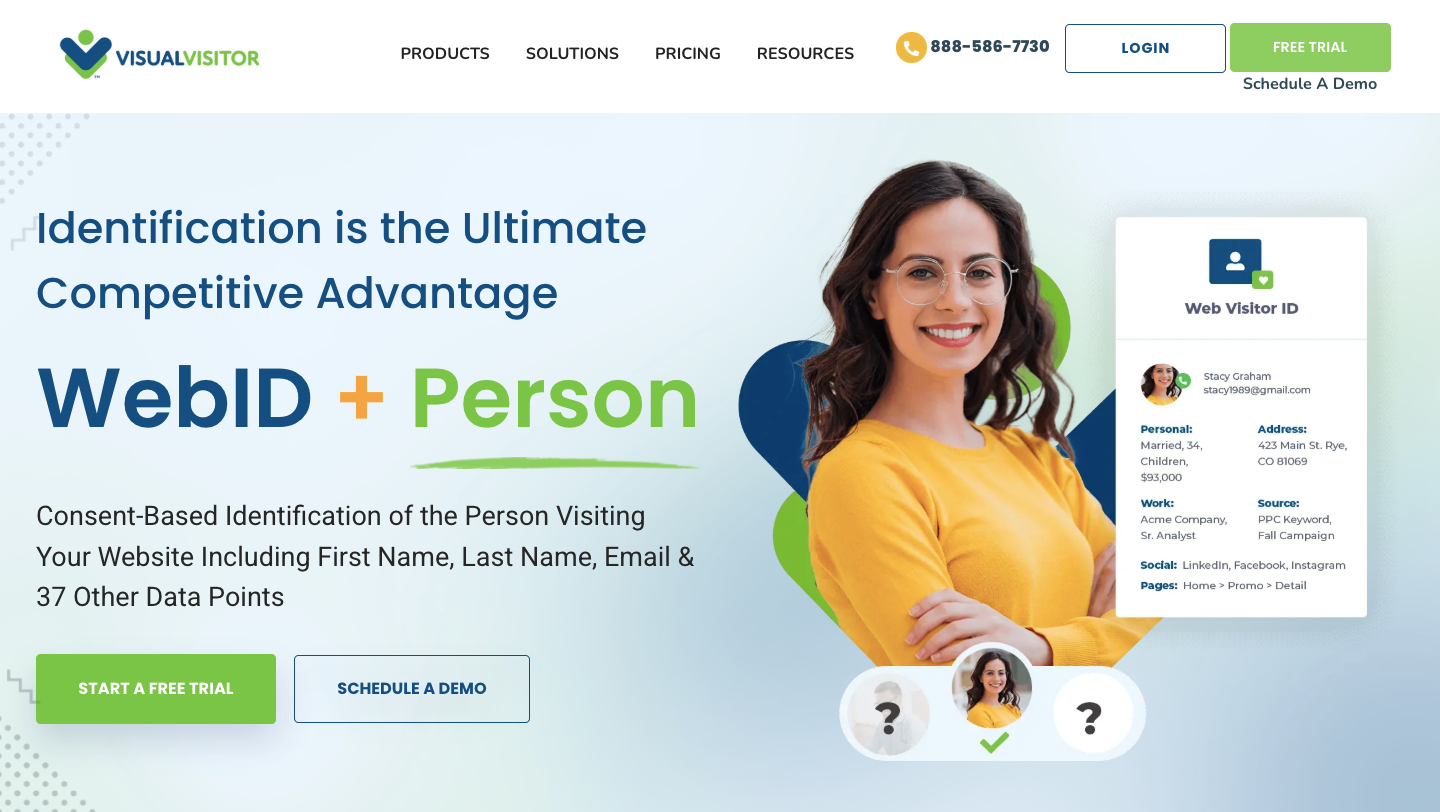
Visual Visitor offers lightweight website visitor identification for teams that just need the basics. It alerts you when known companies hit key pages and includes person-level identification, but doesn’t offer enrichment, routing, or CRM sync.
Its usage-based pricing is available on request, with access to 40 data points and features like AI Sales Rep tools.
Setup is simple, and every tier includes a free trial, making it accessible for smaller teams testing intent data for the first time.
Best for: Solopreneurs, small B2B orgs, and budget-constrained marketing teams.
Snitcher – Best for RevOps alignment between sales & marketing

Snitcher gives sales and marketing teams shared visibility into who’s visiting the site—pushing account-level data directly into your CRM and Slack in real time. It’s comparable to Leadfeeder but with a more modern interface and tighter integrations.
While it doesn’t support advanced scoring or workflow automation, it’s a clean way to align teams around engaged accounts. Plans start at $69/month, with a free trial and flexible scaling for agencies.
Best for: GTM teams who want shared visibility into buyer behavior without full orchestration complexity.
How to choose a website visitor tracking software
Choosing a visitor tracking platform isn’t just about ticking off a checklist of features; it’s about whether your team can act on intent, reduce funnel friction, and drive real pipeline from inbound traffic. The right tool should fit your GTM motion, connect to the rest of your stack, and remove manual steps between signal and sales engagement.
1. Can it act on buyer intent in real time?
First, check how the platform handles real-time buyer behavior. Seeing who’s on your site is step one. The more important question is whether the system can enrich that visit, qualify it on your rules, and automatically route it to the right rep or calendar—while the intent is still fresh. Platforms like Default are built specifically for this kind of orchestration.

2. Does it fit into your GTM stack without ops pain?
If you're already using Salesforce, HubSpot, Slack, enrichment layers, and calendar tools, adding a tracker shouldn’t create new silos. Default, for example, plugs into all of these and updates CRM records and ownership in real-time—without ops teams having to duct-tape it together.
3. Is it built for orchestration—not just tracking?
Finally, ask if the platform supports GTM orchestration—not just visibility. Most tools show you traffic. Fewer let you automate workflows based on that traffic: assign leads, fire alerts, qualify by ICP, and book meetings—all in one canvas. That’s what separates tactical tools from revenue infrastructure.
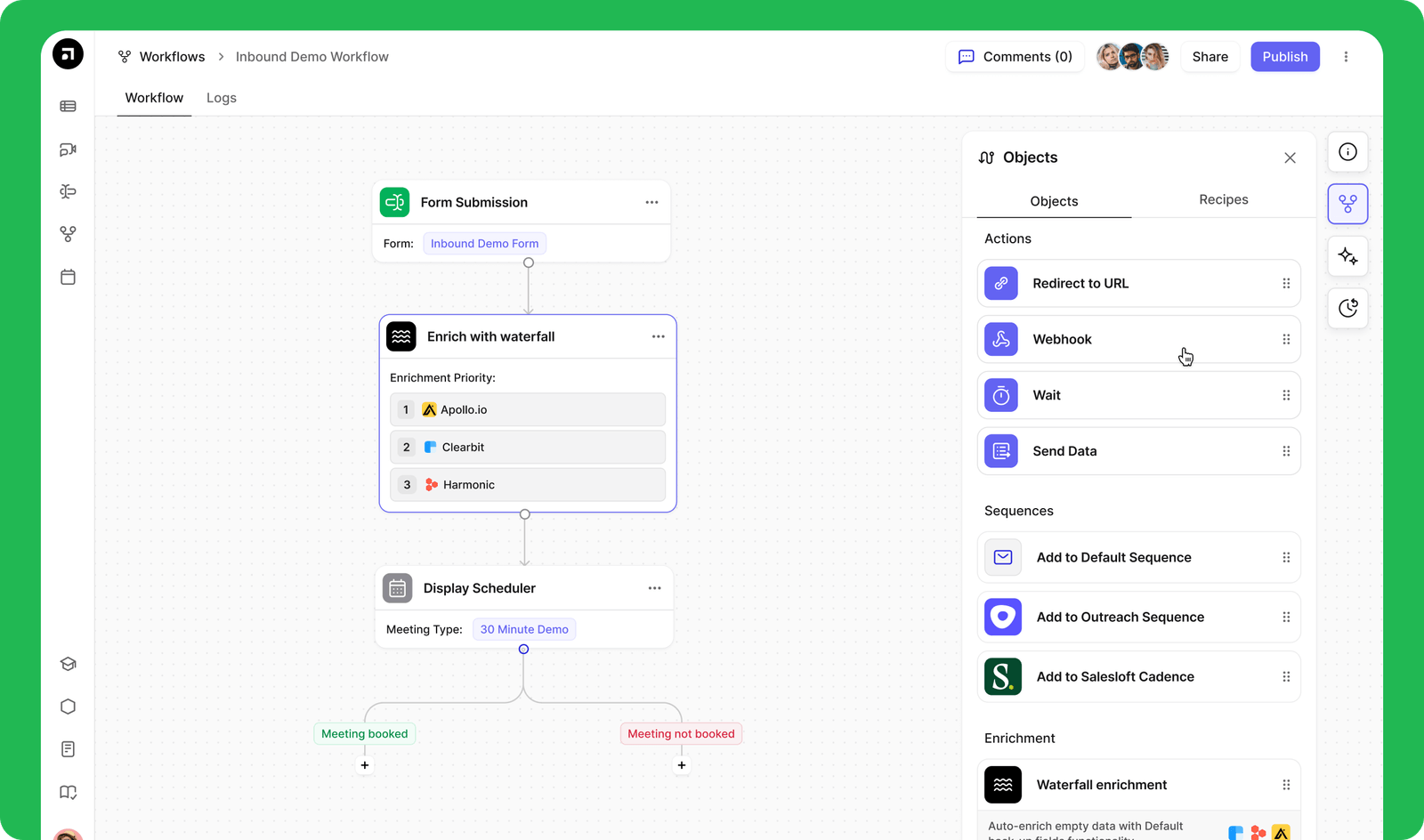
Benefits of a website visitor tracking software
The right tracking software doesn’t just identify visitors—it powers a faster, smarter revenue engine. Here’s what strategic GTM teams gain:
Turn anonymous visits into pipeline
The right platform doesn’t just identify traffic, it becomes the connective tissue between marketing, RevOps, and sales. Done right, visitor tracking translates anonymous sessions into sales-ready signals, so your team can engage the right accounts at exactly the right time.
Reduce lag and manual handoffs
For GTM teams, that means shorter speed-to-lead, cleaner transitions, and far less guesswork. Instead of waiting on MQL thresholds or chasing cold leads, SDRs can prioritize high-intent accounts based on live behavior—like pricing page visits, repeat sessions, or campaign engagement.
When paired with enrichment and scoring, every touchpoint becomes a chance to accelerate pipeline velocity.
Drive RevOps alignment and automation
RevOps teams gain even more. When visitor data powers workflows that sync ownership, trigger alerts, and update the CRM, it becomes a core part of GTM orchestration. That reduces manual work, enforces SLAs, and improves attribution accuracy.
Long-term, it helps clean and align CRM records—sharpening forecasting, reporting, and lead routing.
Sharpen outbound targeting with live signals
For outbound and sales-assist teams, real-time intel helps surface the right accounts before they raise their hand. Knowing which companies are on your site—and what they’re engaging with—lets reps cut through noise and reach out with relevance.
That means fewer cold touches and more conversations with context.
The bottom line
Whether you’re trying to convert more inbound, improve handoff speed, or align your GTM stack around live buyer signals, the right visitor tracking platform does more than show you who’s on your site—it helps you act when it matters most.
Get real-time visitor intelligence with Default
Most tracking tools show you who’s on your site. Default goes further—enriching each visit, qualifying it, routing it, and booking the next step automatically. It’s built for teams that need full-funnel orchestration, not just visibility.
If you’re looking to reduce lead lag, act on buyer intent while it’s live, and simplify your GTM stack into one controllable canvas—Default is designed for that.
For lighter use cases, tools like Leadfeeder or Albacross can help you get started.
Want to see how Default fits your GTM workflows?
Book your free interactive demo today.
Conclusion

Former pro Olympic athlete turned growth marketer! Previously worked at Chili Piper and co-founded my own company before joining Default two years ago.
Accelerate your growth with Default.
Revamp inbound with easier routing, actionable intent, and faster scheduling















.png)


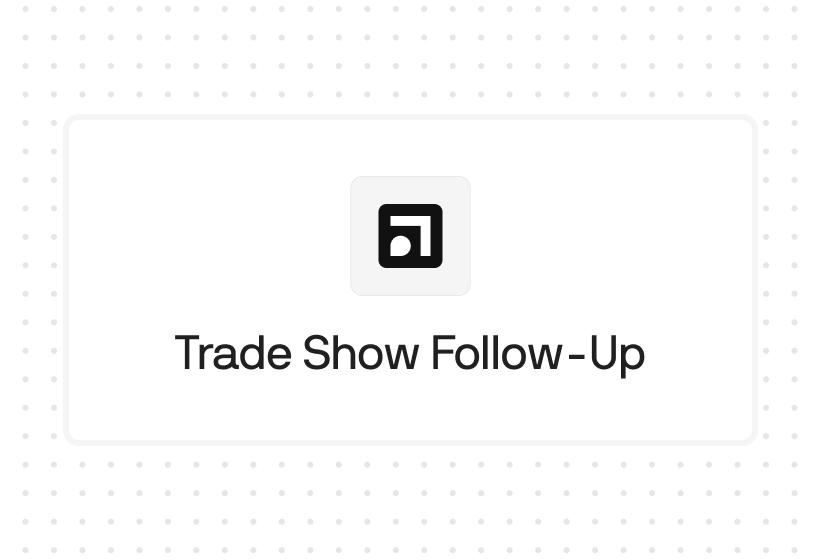
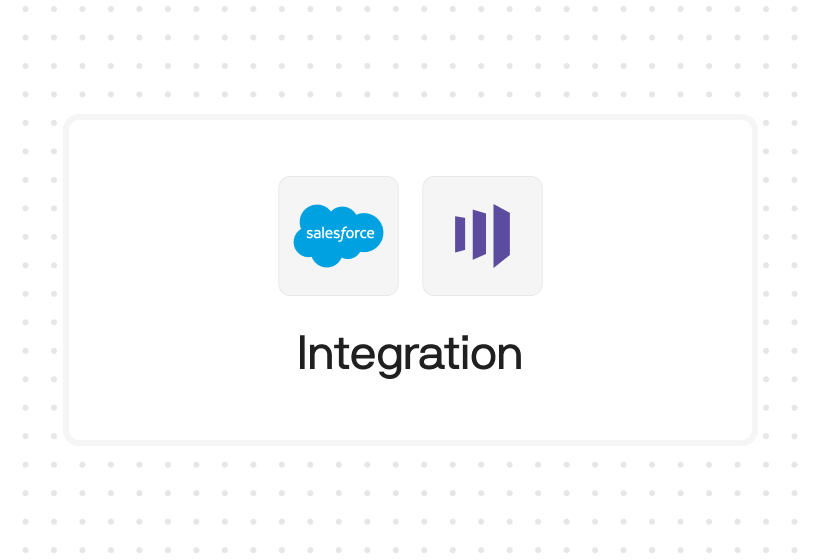




%201.svg)



.svg)





%201.svg)



%201.svg)

